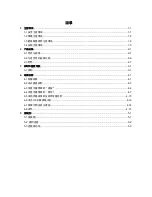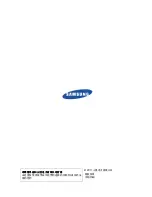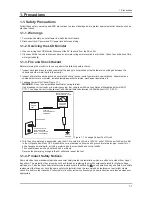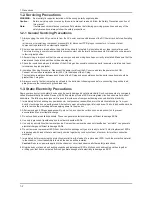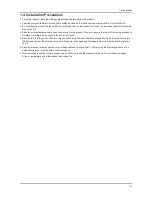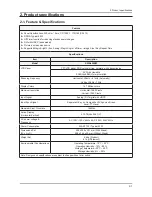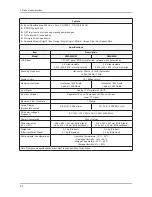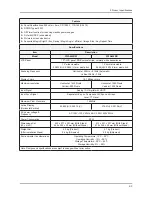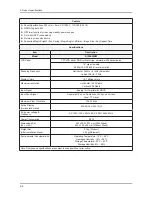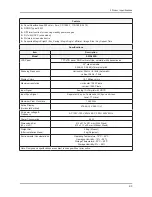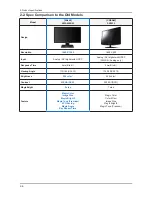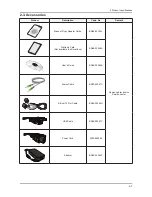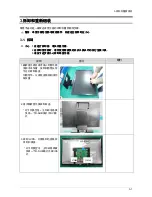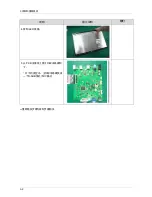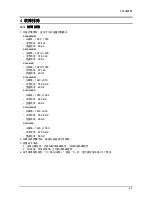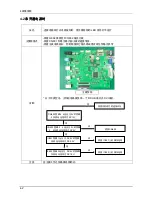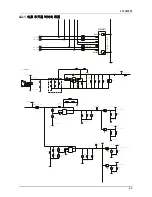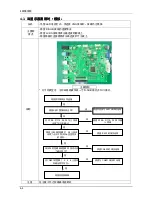
1-2
1. Precautions
1-2. Servicing Precautions
WARNING:
An electrolytic capacitor installed with the wrong polarity might explode.
Caution:
Before servicing units covered by this service manual, read and follow the Safety Precautions section of
this manual.
Note:
If unforeseen circumstances create conflict between the following servicing precautions and any of the
safety precautions, always follow the safety precautions.
1-2-1 General Servicing Precautions
Always unplug the unit’s AC power cord from the AC power source and disconnect the DC Power Jack before attempting
1.
to:
(a) remove or reinstall any component or assembly, (b) disconnect PCB plugs or connectors, (c) connect a test
component in parallel with an electrolytic capacitor.
Some components are raised above the printed circuit board for safety. An insulation tube or tape is sometimes used.
2.
The internal wiring is sometimes clamped to prevent contact with thermally hot components. Reinstall all such elements
to their original position.
After servicing, always check that the screws, components and wiring have been correctly reinstalled. Make sure that the
3.
area around the serviced part has not been damaged.
Check the insulation between the blades of the AC plug and accessible conductive parts (examples: metal panels, input
4.
terminals and earphone jacks).
Insulation Checking Procedure: Disconnect the power cord from the AC source and turn the power switch ON.
5.
Connect an insulation resistance meter (500 V) to theblades of the AC plug.
The insulation resistance between each blade of the AC plug and accessible conductive parts (see above) should be
greater than 1 megohm.
Always connect a test instrument’s ground lead to the instrument chassis ground before connecting the positive lead;
6.
always remove the instrument’s ground lead last.
1-3. Static Electricity Precautions
Some semiconductor (solid state) devices can be easily damaged by static electricity. Such components are commonly
called Electrostatically Sensitive Devices (ESD). Examples of typical ESD are integrated circuits and some field-effect
transistors. The following techniques will reduce the incidence of component damage caused by static electricity.
Immediately before handling any semiconductor components or assemblies, drain the electrostatic charge from your
1.
body by touching a known earth ground. Alternatively, wear a discharging wrist-strap device. To avoid a shock hazard, be
sure to remove the wrist strap before applying power to the monitor.
After removing an ESD-equipped assembly, place it on a conductive surface such as aluminum foil to prevent
2.
accumulation of an electrostatic charge.
Do not use freon-propelled chemicals. These can generate electrical charges sufficient to damage ESDs.
3.
Use only a grounded-tip soldering iron to solder or desolder ESDs.
4.
Use only an anti-static solder removal device. Some solder removal devices not classified as “anti-static” can generate
5.
electrical charges sufficient to damage ESDs.
Do not remove a replacement ESD from its protective package until you are ready to install it. Most replacement ESDs
6.
are packaged with leads that are electrically shorted together by conductive foam, aluminum foil or other conductive
materials.
Immediately before removing the protective material from the leads of a replacement ESD, touch the protective material
7.
to the chassis or circuit assembly into which the device will be installed.
Caution:
Be sure no power is applied to the chassis or circuit and observe all other safety precautions.
Minimize body motions when handling unpackaged replacement ESDs. Motions such as brushing clothes together,
8.
or lifting your foot from a carpeted floor can generate enough static electricity to damage an ESD.
Summary of Contents for SyncMaster S19A200NW
Page 1: ... ...
Page 2: ... 0 12 34 0 12 56 78 9 8 A 5B 0CDEFGH IJ KLM KLM KLM KLM KLM NOPK PK QR ...
Page 3: ... S TUVWX Y Z S TUVWX Y Z S TUVWX Y Z S TUVWX Y Z _ abcTUdRefgb hi 9hjk l mn WX Y Z o phqr ...
Page 7: ...1 4 1 Precautions Memo ...
Page 16: ...3 j u vwxyEfgh ij A abcde fgh ijkl m Fno Fn z ...
Page 17: ... 0 y 12 3456 0789 56 0789 y 56 0789 ABC D E F BG H IJKLMN OPQRS ...
Page 18: ... TU VWX YZ IJK J _ a b cde f 3 eIJKg 7 hi 7 jZ klf mnop qrf st 7 uvjwxy 56 07z 7P X ...
Page 20: ... TU WX Z a b hi op 7 7 Kop 7 7 uvjwxy 56 07z 7P X 01 2 34 56 7 2 7 89 ...
Page 22: ... ...
Page 23: ... TU WX Z a b hi op 7 7 Kop 7 7 uvjwxy 56 07z 7P X 7 89 01 2 34 56 7 2 ...
Page 25: ... 4 9 ...
Page 26: ... TU IJ o K f a b k hi op K op 7 7 uvjwxy 56 07z 7P X 56 AB C D E FG H IJ F 56 ...
Page 28: ... TU f a b fO fO 7 uvjwxy 56 07z 7P X K 56 AB C 56 ...
Page 33: ... y Y Â X ÂÃ 7Z ÂÃ 7Z ÂÃ 7Z ÂÃ 7Z ÂÃ 7V 7ÐçC A YG H 7 ÇL ZÖ ªLÂ ë ...
Page 34: ... fO fO fO fO ñÌ K æ ÂÅ b WX n WX 9 Cb E Y b Y fO yC EB fO ê V fO ë ÄR óý ...
Page 35: ... fO fO fO fO WX 01234 564 V Ð Ð P n P w MN EÂ ...
Page 36: ... b ûO 9 Y îï 9 Cb WX Y ...
Page 37: ... b MN Y ýe 0 V ð C ËN ...
Page 38: ... fOîï fOîï fOîï fOîï 1647 86 6 6 9 b Y ...
Page 39: ... b 1O YC 5049 B fO B0 ...
Page 40: ... ...
Page 41: ...5 1 5 Wiring Diagram 5 Wiring Diagram 5 1 Wiring Diagram ...


